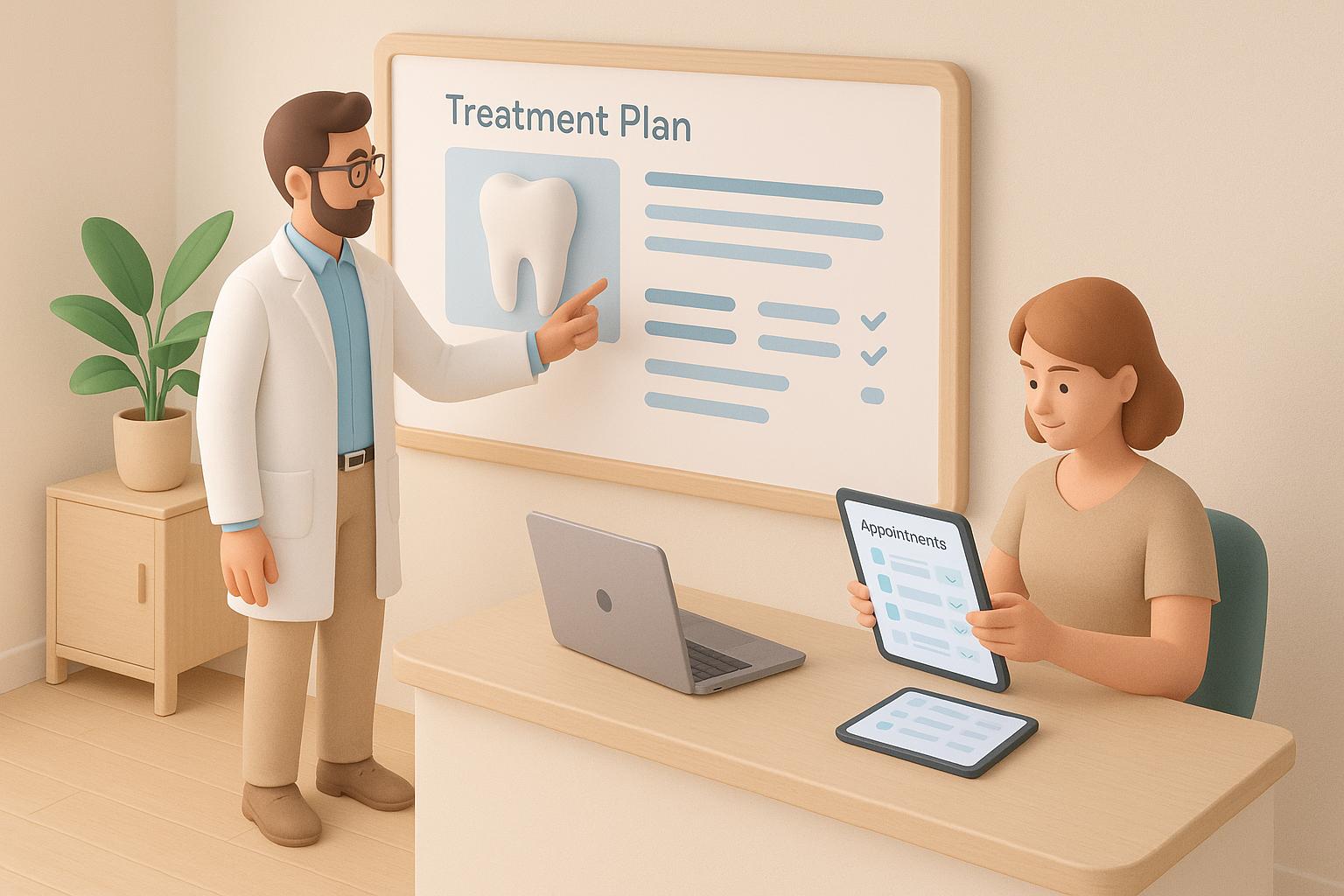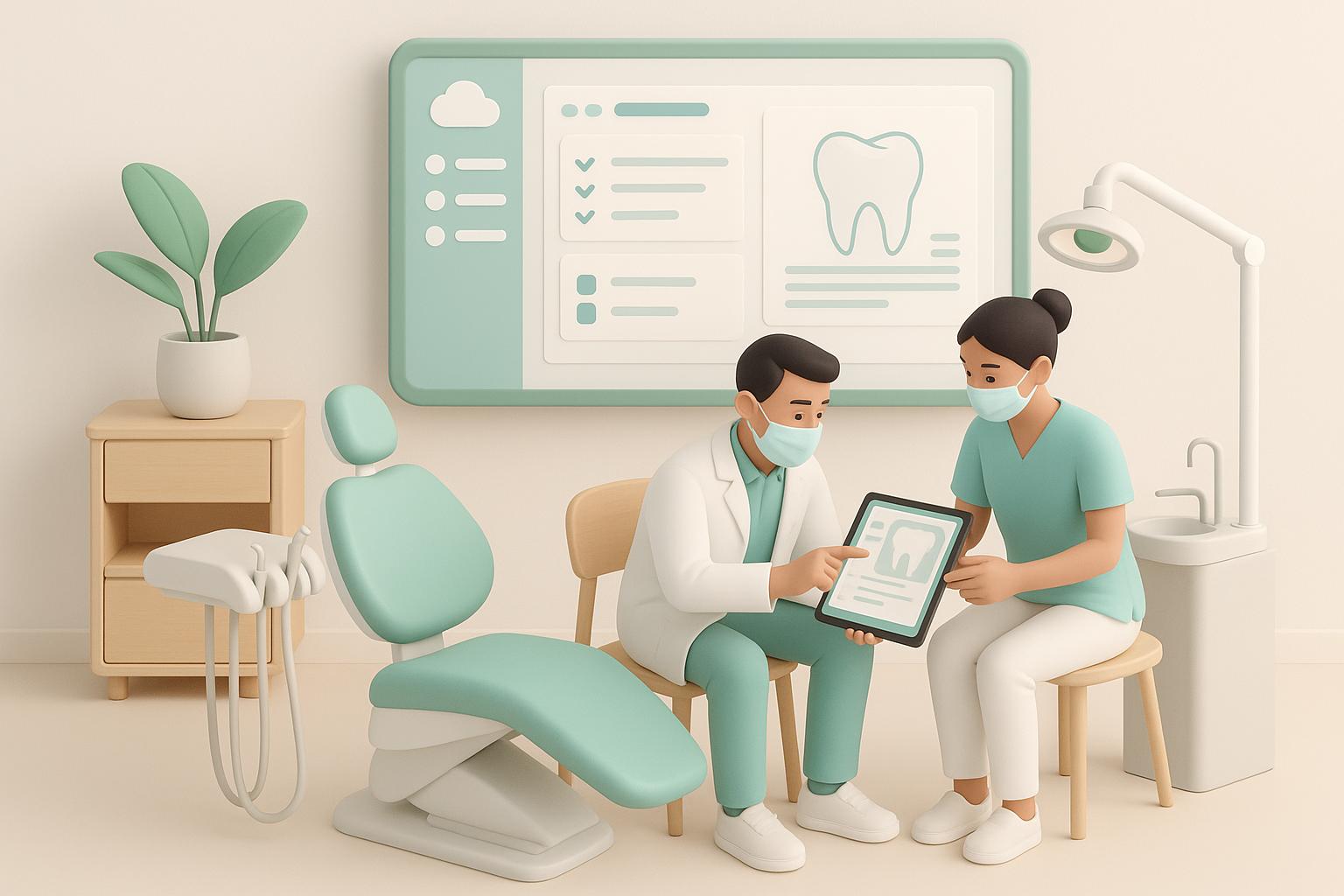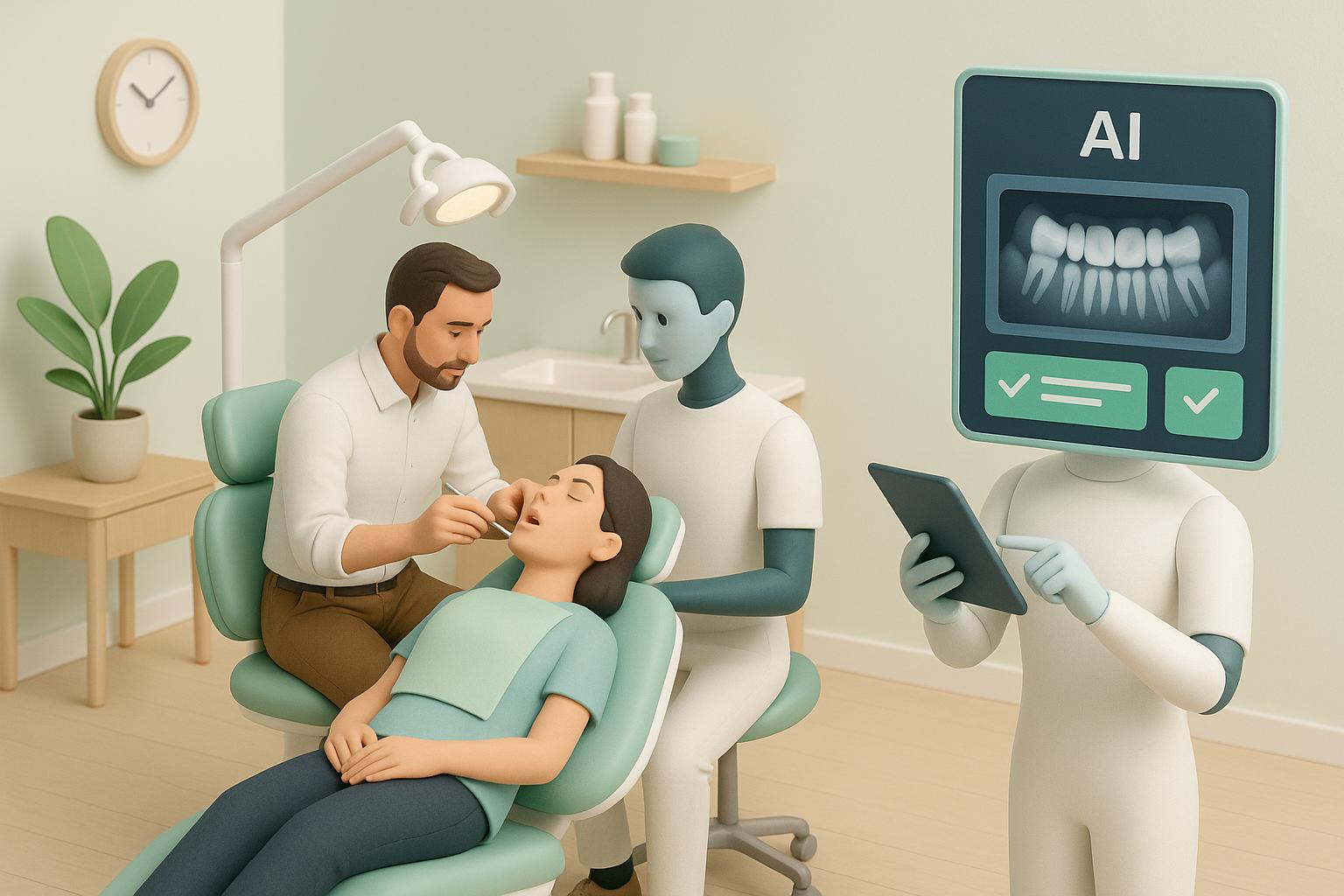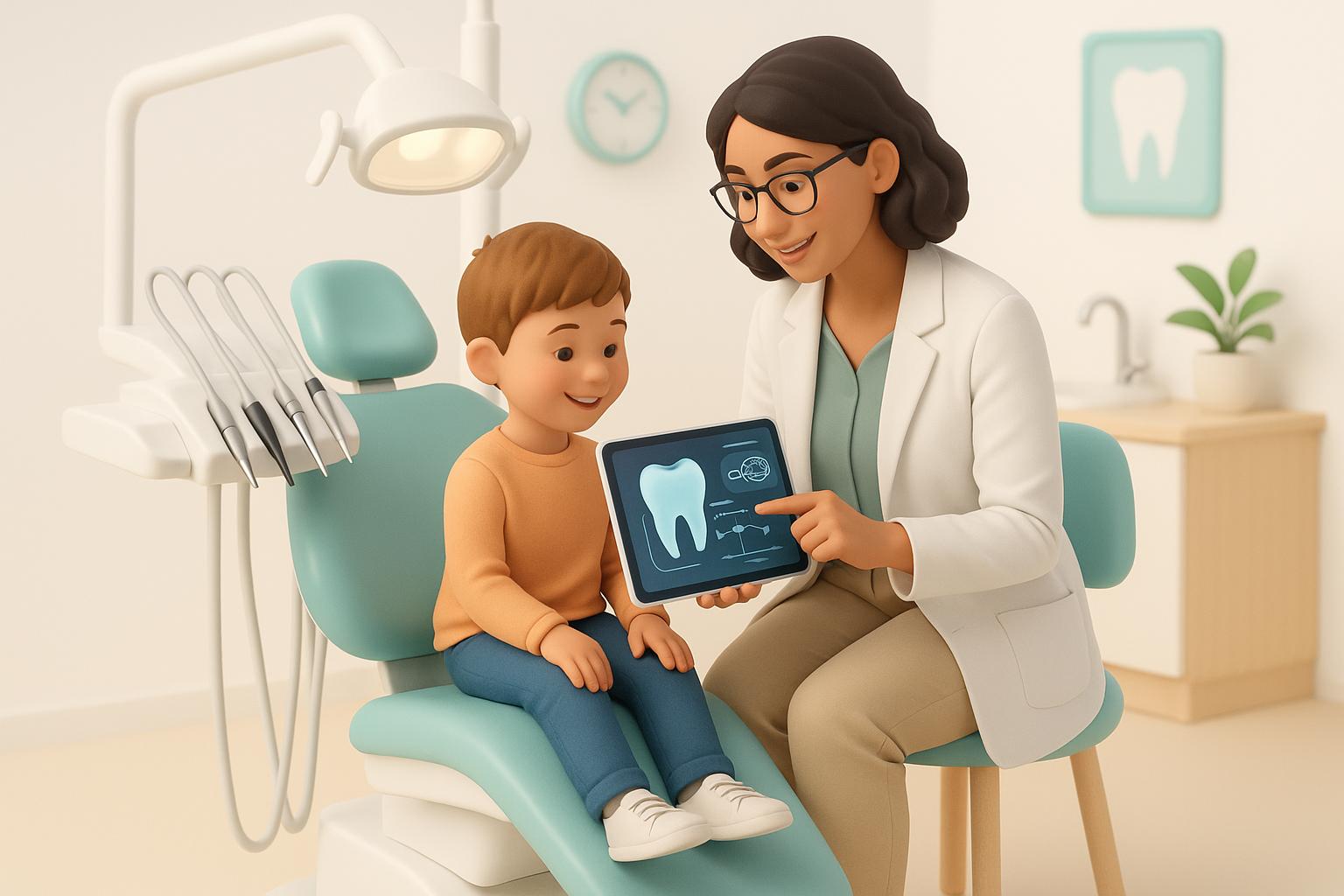Dental Practice Management Software: How It Streamlines Your Clinic
Dental practice management software simplifies running a clinic by handling tasks like scheduling, billing, and patient records in one system. For UAE clinics, it ensures compliance with NABIDH and Riayati standards while improving efficiency and patient care. Key benefits include:
- Reduced Administrative Work: Automates scheduling, billing, and insurance claims, saving up to 15 hours weekly.
- Fewer No-Shows: Automated reminders cut missed appointments by up to 23%.
- Centralised Patient Records: Securely stores data, improving accuracy and compliance.
- Improved Billing: Online payments and automated reminders boost collection rates by 33%.
- Enhanced Communication: SMS, email, and patient portals keep patients engaged.
- Cloud-Based Access: Manage operations securely from anywhere.
For clinics in competitive markets like Dubai, adopting this software can increase efficiency, reduce errors, and improve patient satisfaction, all while meeting regulatory requirements.
Top 10 Best Dental Practice Management Systems in 2025
What is Dental Practice Management Software and Why Clinics Need It
Dental practice management software serves as a digital command centre for clinics, streamlining both administrative and clinical tasks into a single, cohesive system. It connects essential functions like appointment scheduling, patient records, billing, insurance claims, and compliance tracking - all under one roof.
This integration helps reduce errors. For example, when a patient books an appointment online, their details are automatically synced across patient records, billing systems, and treatment planning tools. This eliminates the need for staff to re-enter the same information multiple times, saving time and reducing mistakes.
The software also tackles time-consuming tasks through automation. It sends appointment reminders via SMS or email, verifies insurance eligibility instantly, digitises patient forms, and submits claims electronically with greater accuracy.
Core Functions and Features
Most dental management systems focus on five main areas:
- Appointment Management: Goes beyond simple scheduling. Patients can book appointments online, receive automated reminders to minimise no-shows, and be added to waitlists when cancellations occur. Staff can view real-time availability across multiple providers and locations, ensuring smooth scheduling.
- Patient Records and Clinical Documentation: Stores patient data securely in the cloud, including dental charts, treatment histories, clinical notes, digital X-rays, and treatment plans. These systems often integrate with imaging equipment, offering a complete view of patient profiles.
- Billing and Financial Management: Simplifies administrative work by processing insurance claims electronically, verifying patient eligibility in real time, and managing payment processing. Features like automated payment reminders and online payment options help improve cash flow.
- Patient Communication Tools: Keeps patients engaged between visits through two-way text messaging, email campaigns, and recall reminders. These tools enhance communication and patient satisfaction.
- Practice Analytics and Reporting: Provides insights into clinic performance by tracking metrics like no-show rates, treatment acceptance, revenue trends, and staff productivity. These data-driven insights support better decision-making and operational improvements.
Each of these features addresses common challenges faced by dental practices, making daily operations more efficient and effective.
Problems It Solves for Dental Clinics
Understanding these core features highlights how the software helps clinics overcome everyday hurdles, particularly in regions where balancing efficiency with regulatory compliance is critical.
- Administrative Overload: Manual booking, paper forms, and repetitive data entry waste valuable time. Automation can free up as much as 15 hours per week, allowing staff to focus on patient care [6].
- Missed Appointments and Scheduling Conflicts: No-shows disrupt patient flow and revenue. Automated reminders reduce these occurrences, while waitlist management fills cancelled slots quickly.
- Billing Errors and Payment Delays: Manual claims processing often leads to mistakes and slower payments. Electronic claims submission and real-time insurance verification streamline this process, improving accuracy and cash flow.
- Disorganised Patient Data: Inconsistent records can compromise care and compliance. Centralised, secure patient records ensure team members have access to up-to-date information, meeting local standards like NABIDH and Riayati.
- Poor Patient Communication: Lack of follow-up and engagement leads to missed appointments and lower treatment acceptance rates. Research shows that 83% of patients prioritise features like digital scheduling and online payment options when choosing healthcare providers [1].
- Regulatory Compliance Challenges: Clinics must adhere to standards such as NABIDH and Riayati. Robust software ensures proper documentation, audit trails, and data security to meet these requirements.
“Protecting patient data is another critical benefit. Quality dental software provides encryption, secure data storage, access controls, and compliance with local standards.” - Kwikly Dental Staffing [2]
The financial benefits are clear. Clinics using comprehensive management software report an 85% improvement in patient experiences [4], while automated billing systems can boost collection rates by up to 33% [2]. For practices in competitive markets like Dubai and Abu Dhabi, these enhancements in efficiency and patient satisfaction can make all the difference.
How Dental Practice Management Software Improves Daily Operations
Dental practice management software simplifies and streamlines daily operations by bringing essential tasks under one unified system. This integration not only boosts efficiency but also enhances patient satisfaction and revenue generation.
Better Scheduling and Fewer No-Shows
Multi-channel reminder systems - using SMS, email, phone calls, and even postcards - help keep appointments on patients’ radar. Sending reminders at key intervals, like two weeks, two days, and the day of the appointment, caters to different preferences and ensures patients stay informed.
Two-way texting adds another layer of convenience, allowing patients to confirm or reschedule with ease. This reduces missed appointments while freeing up staff to focus on other tasks. In fact, practices using automated reminders have seen no-show rates drop by as much as 23% [9]. Some, leveraging AI voice technology, have reported even greater success, with rates falling from 20.99% to 7.07% [9].
“We know that the patient will be coming tomorrow, and we don’t have to do the extra work.” - Dr. Rahul Patel, Priti Patel DDS [8]
Real-time calendar integration ensures an up-to-date view of the schedule, avoiding double bookings. Smart waitlist features can quickly fill last-minute cancellations, turning potential losses into revenue.
The financial impact of missed appointments is no small matter. For example, a practice with 10 daily appointments, a 15% no-show rate, and an average appointment value of AED 735 could lose around AED 220,000 annually [9]. Text message reminders, which boast up to 40% higher response rates than phone calls [9], are particularly effective in the UAE, where patients often avoid answering calls from unknown numbers.
Combined Patient Records and Billing
Centralising patient records and billing processes is another way these systems enhance daily operations. Automated claims and real-time insurance verification reduce errors and speed up payments, ensuring practices know coverage details before appointments. This not only prevents billing surprises but also improves cash flow.
Online payment options and automated reminders simplify billing for both patients and practices. These tools have been shown to increase collection rates by up to 33% [2], directly improving profitability.
Digital patient forms replace traditional paper-based processes, allowing patients to complete their intake forms online. The data flows directly into their records, reducing waiting times and ensuring accuracy.
For practices in the UAE, compliance with regulations like NABIDH and Riayati is critical. Integrated systems help manage documentation and audit trails while adhering to these standards, making regulatory compliance far easier to handle.
Better Patient Communication
Clear and consistent communication is vital, especially in competitive markets like the UAE.
Automated follow-up systems keep patients engaged between visits with personalised messages tailored to their treatment history. These can include post-operative care instructions, reminders for upcoming treatments, or notifications for routine check-ups.
Multi-channel communication options, such as SMS and email, meet modern patient expectations. Research shows that nearly 70% of patients prefer these methods for updates and reminders [11]. Practices can easily adapt to these preferences while maintaining consistent contact.
Patient portals offer secure, two-way communication, giving patients access to treatment details and the ability to ask questions or clarify instructions. This builds trust and ensures patients feel informed about their care.
“It’s super easy, super convenient, and it allows us to communicate with our patients in real time.” - Chrissy Collins, Business Assistant, Smile Design Studios Dentistry [8]
Treatment plan follow-ups use automation to remind patients about pending treatments and associated costs, encouraging them to stay on track with their oral health goals.
Review and feedback management systems automate the collection of patient reviews, helping practices manage their online reputation. Positive experiences are shared through automated prompts, while any issues are quickly addressed via direct communication.
These communication tools deliver tangible results. For example, PracticeMojo, which integrates with systems like Dentrix and Eaglesoft, helps practices add an average of 2.5 appointments per day while saving over 40 hours a month on patient communications [7].
“I specifically like the appointment reminders and recall and reactivate postcards. Whenever I call, their staff answers right away and is very knowledgeable and helpful. There are so many benefits to this service, we would recommend PracticeMojo to every dental practice.” – Julie Esses, Partnered Plan, Doueck Dental [7]
The shift to digital communication platforms addresses a growing challenge: the majority of people, including those in the UAE, avoid answering calls from unknown numbers. By adapting to this trend, practices can ensure better engagement with their patients.
sbb-itb-d8b42ea
Must-Have Features in Dental Practice Management Software
Choosing the right dental practice management software can significantly boost efficiency, ensure compliance, and enhance patient engagement. The global market for these systems hit USD 2.71 billion in 2024 and is expected to grow to USD 6.77 billion by 2033, with an annual growth rate of 10.8% [14]. This rapid expansion underscores how critical these tools have become for modern dental practices.
The patient communication segment currently holds the largest market share at 34.82%, while dental clinics contribute 47.48% of total revenue [14]. These figures highlight the importance of features like cloud access, robust security, and detailed analytics.
Cloud vs Desktop Software: Which Works Better
When it comes to dental software, the choice between cloud-based and desktop systems has become a lot clearer. Web-based solutions led the market in 2024 with a 55.57% revenue share [14], and a growing number of dental practices are switching to cloud-based platforms [15].
Cloud-based systems typically cost AED 735 per provider each month [5][3], while on-premise solutions demand a hefty upfront investment, ranging from AED 36,750 to AED 183,750, along with ongoing maintenance costs [5]. However, the real distinction lies in their functionality and ease of use.
Feature | Cloud-Based Software | Desktop Software |
|---|---|---|
Initial Cost | Low monthly fee (AED 735-1,835/provider) | High upfront cost (AED 36,750-183,750) |
Access | Accessible from anywhere with internet | Limited to office computers |
Updates | Automatic updates and patches | Manual installation needed |
Maintenance | Included in subscription | Requires IT expertise |
Data Backup | Built-in redundancy with off-site storage | Local backups, prone to risks |
Scalability | Easy to expand users and locations | Needs hardware upgrades |
For example, ROOT Periodontics & Implant Centers in Dallas, Texas, saw a 35% increase in gross production and a 29% rise in new patient acquisition after adopting CareStack’s cloud-based system. They utilised centralised reporting and analytics across their seven locations [14].
“Robust reporting and analytics - provided me with a better way to watch the numbers and see things real time and quickly. All our KPIs have improved. Overall, we have seen our business improve since being on CareStack.” - Dana Veach, COO, ROOT Periodontics & Implant Centers [14]
Cloud platforms also integrate seamlessly with advanced tools like AI-powered dental diagnostics. For instance, in April 2025, Sensei and DentalMonitoring announced their integration to incorporate AI-based remote monitoring into Sensei Cloud Ortho [14].
Security and compliance are just as crucial as cost and convenience when selecting software.
Compliance and Security Requirements
Dental practices must adhere to strict data privacy regulations, including GDPR in Europe and NABIDH standards in the UAE. Other countries in the MENA region, like Kuwait, enforce similar standards through laws such as the Data Privacy Protection Regulation, No. 42 of 2021 [14].
Key security features to look for include encrypted storage, strict access controls, and automatic backups [17][18]. CareStack sets a high bar with certifications like HIPAA, SOC 2 Type 2, and ISO 27001:2022, ensuring it meets globally recognised security standards [16].
Modern systems also support patient rights, such as the ability to review or delete their data, as required by GDPR [17][18]. Pearl Dental Software, for example, offers features like password management, automatic encrypted backups, and tools to record patient consent for marketing while allowing patients to adjust permissions [18].
“All of our software and systems are designed with the most stringent information protections in mind, and we value your trust in our business.” - Carestream Dental [17]
Being prepared for data breaches is equally important, as GDPR mandates reporting incidents within 72 hours [19]. Software should enable quick breach reporting and offer secure remote access options that require explicit consent [17][19].
For practices managing significant amounts of data, appointing a Data Protection Officer (DPO) is advisable. This role oversees compliance strategies and acts as the main contact for regulators. Additionally, the software should maintain detailed records of how patient data is collected, processed, and stored to demonstrate compliance [19].
Analytics and Multi-Branch Management
Analytics dashboards are now essential for tracking clinic performance and making informed decisions. These tools can help identify trends, forecast revenue, and monitor key performance indicators in real time.
The Middle East and Africa dental practice management software market is projected to reach USD 341.28 million by 2030, growing at an annual rate of 9.9% [13]. This growth is partly driven by Dental Support Organizations (DSOs), which use practice management software to streamline operations and cut costs [12].
For multi-location practices, multi-branch management features are invaluable. These tools centralise data management while maintaining operational consistency across locations. Unified reporting ensures that practices can monitor performance across all branches while preserving the autonomy of individual clinics.
In May 2025, RevenueWell partnered with Mila Health to launch an AI-powered assistant that improves patient experience with 24/7 service, automates 90% of care management tasks, and significantly reduces no-show rates [14]. Such AI-driven analytics are becoming the cornerstone of modern practice management.
Integration capabilities also play a key role. For example, in January 2025, Pearl partnered with Centaur to expand the use of its Second Opinion AI diagnostic software across Australia and the Middle East. This move aims to improve diagnostic accuracy and clinical efficiency [14].
“Second Opinion represents the next generation of diagnostic tools for the dental profession. By incorporating AI-powered evaluations, we’re enabling dental professionals across the Asia Pacific and Middle East to improve diagnostic accuracy, streamline patient communication, and ultimately deliver a higher standard of care.” - Sean Perera, CTO of Centaur [14]
Real-time financial insights allow practices to track revenue, manage outstanding payments, and identify profitable treatments. When combined with treatment planning integration, these features offer a comprehensive view of a clinic’s financial health and patient care quality. Together, these capabilities ensure smoother operations and better patient outcomes.
What Most People Get Wrong About Dental Practice Management Software
Many dental practice owners hold onto misconceptions about practice management software. These misunderstandings can lead to poor decisions, but the reality is that today’s software solutions are affordable, flexible, and easy to use. By addressing these myths, you can make an informed choice that aligns with your clinic’s unique needs.
“It’s Too Expensive for Small Practices”
One of the most common myths is that dental practice management software is out of reach for smaller or single-location clinics. However, this isn’t the case. Entry-level plans can start as low as AED 37 per month, while mid-tier options range between AED 210 and AED 613 monthly [20]. For example, Open Dental is not only budget-friendly but also offers the advantage of no long-term contracts, making it a great choice for practices wanting to try out a system without a hefty upfront commitment.
“Open Dental just works. It’s fast, straightforward, and I’m not being nickel-and-dimed for every feature.” – Dentist [15]
The real challenge often lies in hidden costs. Beyond the monthly subscription fee, you’ll want to ask about onboarding, support, training, and add-ons like e-claims, imaging, or analytics. Knowing the total cost upfront can help you avoid unexpected charges for features you assumed were included [15].
“All Software is One-Size-Fits-All”
Another misconception is that dental software lacks the flexibility to cater to specific clinic needs. In truth, modern cloud-based solutions are highly adaptable, offering tools designed for various specialties, from orthodontics to oral surgery [21]. For example, platforms like Curve Dental provide specialty-specific features that can be tailored to your clinic’s workflow.
“Since there is no one-size-fits-all, many clinics and practices look for custom software tailored to their needs and schedules.” – TRIARE [22]
Before diving into software options, take the time to document your clinic’s daily operations and pinpoint any challenges you face. This preparation will help you ask the right questions about customisation and ensure the software you choose fits your specific requirements [21].
“Migration Will Disrupt My Practice”
The thought of data migration often brings up fears of operational disruptions. However, modern software providers have addressed this concern with secure and comprehensive migration processes [15]. Providers offering encrypted migration protocols and dedicated support can make the transition seamless, helping you avoid unnecessary downtime.
“Complex Software Requires Extensive Training”
It’s easy to assume that robust software comes with a steep learning curve, but that’s no longer the case. Today’s dental management systems are designed with user-friendly interfaces to minimise training time. For instance, DentiMax focuses on simple, intuitive designs that make it easier for teams to get up to speed quickly [15].
“It’s simple, it works, and the support is responsive.” – General Dentist on ACE Dental [15]
Cloud-based systems add even more convenience, allowing staff to access the software from anywhere. Automatic updates eliminate the hassle of manual installations or maintenance, making adoption smoother and less stressful [15].
Key Takeaways
Dental practice management software can reduce no-show rates by as much as 35% [10], while also streamlining billing processes. This not only cuts down on errors but also improves cash flow and ensures smoother day-to-day operations.
Another major advantage is enhanced patient engagement. Features like automated reminders, secure messaging, and online booking portals make it easier for patients to manage their appointments independently and stay informed with timely updates. These tools help build stronger relationships between practices and their patients.
Cloud-based solutions bring added convenience by allowing access to patient data and billing from anywhere. With analytics tools, practices can increase financial performance by up to 25% [10]. This is especially beneficial for practices with multiple locations or those that require remote work capabilities.
Security is another priority, with built-in data encryption, user authentication, and regular backups ensuring compliance with regulations while safeguarding sensitive patient information - without the need for constant manual oversight.
Finally, scalable cloud systems are designed to grow with your practice. You can easily add users, new locations, or additional features as needed [23]. These systems also improve financial oversight through integrated dashboards that track key performance indicators and revenue trends, helping you make smarter decisions about staffing and services.
FAQs
How can dental practice management software help reduce missed appointments and improve scheduling efficiency?
Dental practice management software helps minimise missed appointments and streamlines scheduling by utilising automated reminders. These reminders - delivered through SMS, email, or phone calls - keep patients well-informed about their upcoming visits, which can greatly reduce no-show rates.
On top of that, tools like online booking and real-time schedule updates allow patients to easily confirm or reschedule their appointments when it suits them. This not only boosts patient satisfaction but also ensures your clinic runs more smoothly, saving valuable time for both your team and your patients. :::
What compliance and security features should dental practice management software have to meet UAE regulations like NABIDH and Riayati?
Dental clinics in the UAE require management software that prioritises patient privacy and data security. Features like secure data encryption, role-based access controls, and audit trails are essential for safeguarding sensitive information. These tools also help clinics comply with stringent local regulations, including NABIDH and Riayati.
Another key requirement is the ability to integrate seamlessly with government health portals. This functionality simplifies the process of submitting reports and sharing data with authorities, ensuring clinics meet official standards. By adhering to these requirements, clinics can minimise regulatory challenges while fostering trust with their patients. :::
What are the benefits of using cloud-based dental practice management software for multi-location clinics?
Cloud-based dental practice management software streamlines operations for clinics with multiple locations by offering real-time access to centralised data. This allows authorised staff to securely access patient records, appointment schedules, and financial details from any branch, ensuring smooth and consistent care across the board.
By removing the need for manual data transfers, cloud systems not only save time but also minimise errors. Tools such as appointment management systems and patient flow tracking integrate seamlessly across all locations, boosting efficiency while enhancing the overall patient experience. These features make cloud-based solutions a smart choice for clinics looking to scale and manage multiple branches with ease. :::







 International
International  UK
UK  Kuwait
Kuwait  Nigeria
Nigeria  Kenya
Kenya  Japan
Japan  USA
USA  France
France  UAE
UAE  South Africa
South Africa  Ethiopia
Ethiopia  Australia
Australia  Canada
Canada  Germany
Germany  Bahrain
Bahrain  Egypt
Egypt  India
India  Pakistan
Pakistan  Mexico
Mexico  Switzerland
Switzerland  Qatar
Qatar  Algeria
Algeria  Angola
Angola  Malaysia
Malaysia  Argentina
Argentina  Italy
Italy  KSA
KSA  Morocco
Morocco  Ghana
Ghana  Indonesia
Indonesia  Brazil
Brazil  Austria
Austria  Turkey
Turkey  Côte d’Ivoire
Côte d’Ivoire  South Korea
South Korea  Colombia
Colombia 

































